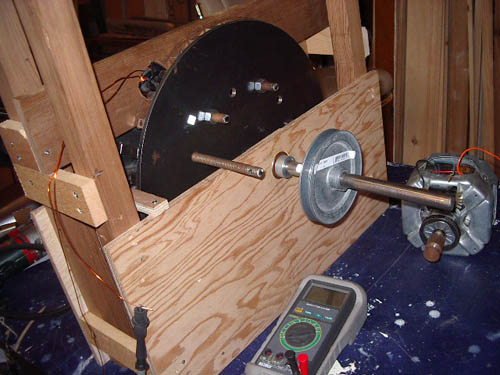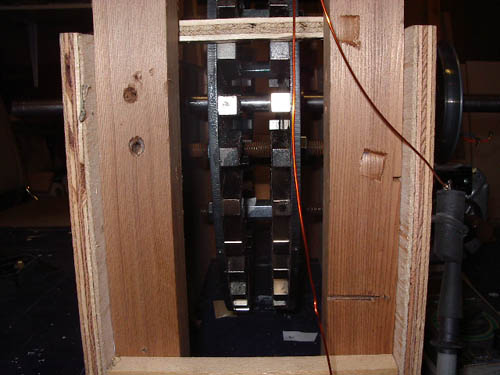I have constructed a steel dbl rotor, as I threatened in last my posting. Here are some photos and test results. Can anyone verify these figures? I personally don't think they can be correct. If they are I have created a monster. My intention was to generate heat for my garage next winter. Little did I realize I would need a prop the size of my house, and 50 ft in the air, Bet the neighbours notice LOL.
I've got a few mechanical bugs to work out, wobbling, stator construction, housing, decent bearings, attachment to the shaft and support within the housing. Other than that I'm off to the races.
I'm learnin' a lot an' hav'in fun.
By the way, the electric motor in one of the photos is fairly new from a dryer. Can anyone help me with a way to hook it up so I can turn my creation instead of using a drill?
Thanks.
Values are projected after 1 coil tested at the stated RPM.
2 of 16" x ¼" iron Rotors, 72 of magnets 1/2" x 1/2" x2" , coils 125 turns of 18 g copper
RPM I = E/R P = E x I
200 Ohms Hz Volts Amps Watts Avg.P per
R E I P
- Coil 0.5 60 9.3 18.6 172.98 173.0
- Coil Series 1 60 18.6 18.6 345.96 173.0
- Coil Series 1.5 60 28 18.6 518.94 173.0
- Coil Series 3 60 56 18.6 1037.88 173.0
- Coil Series 4.5 60 83.7 18.6 1556.82 173.0
- Coil Series 9 60 167 18.6 3113.64 173.0
- parallel of 9 series coils 2.25 60 83.7 37.2 3113.64 173.0
- parallel of 6 series coils 1 60 55.8 55.8 3113.64 173.0
- parallel of 3 series coils 0.25 60 27.9 111.6 3113.64 173.0
- of 16" x ¼" iron Rotors, 72 of magnets 1/2" x 1/2" x2" , coils 125 turns of 18 g copper
RPM Increased x 1.29 I = E/R P = E x I
260 Ohms Hz Volts Amps Watts Avg.P per
R E I P
- Coil 0.5 78.0 12 24.0 288.00 288.0
- Coil Series 1 78.0 24 24.0 576.00 288.0
- Coil Series 1.5 78.0 36 24.0 864.00 288.0
- Coil Series 3 78.0 72 24.0 1728.00 288.0
- Coil Series 4.5 78.0 108 24.0 2592.00 288.0
- Coil Series 9 78.0 216 24.0 5184.00 288.0
- parallel of 9 series coils 2.25 78.0 108 48.0 5184.00 288.0
- parallel of 6 series coils 1 78.0 72.0 72.0 5184.00 288.0
- parallel of 3 series coils 0.25 78.0 36.0 144.0 5184.00 288.0
- of 16" x ¼" iron Rotors, 72 of magnets 1/2" x 1/2" x2" , coils 125 turns of 18 g copper
RPM Increased x 1.72 I = E/R P = E x I
334 Ohms Hz Volts Amps Watts Avg.P per
R E I P
- Coil 0.5 100.2 16 32.0 512.00 512.0
- Coil Series 1 100.2 32 32.0 1024.00 512.0
- Coil Series 1.5 100.2 48 32.0 1536.00 512.0
- Coil Series 3 100.2 96 32.0 3072.00 512.0
- Coil Series 4.5 100.2 144 32.0 4608.00 512.0
- Coil Series 9 100.2 288 32.0 9216.00 512.0
- parallel of 9 series coils 2.25 100.2 144 64.0 9216.00 512.0
- parallel of 6 series coils 1 100.2 96.0 96.0 9216.00 512.0
- parallel of 3 series coils 0.25 100.2 48.0 192.0 9216.00 512.0


Note the threaded bar sticking out of the rotor. I drilled and taped six holes on one of the rotors to facilitate disassembly. They work like a charm and only 3 are really needed.
I am planning a vertical helix, or mabey horizontal, i dunno. I thinking the full length of the peak of my garage roof would work well to collect wind for horizontal helix. Comments welcome.